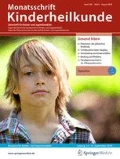Zusammenfassung
Das Retinoblastom ist der häufigste bösartige Augentumor im Kindesalter. Die wichtigsten Erstsymptome sind Leukokorie und Strabismus. Bei frühzeitiger Erkennung, solange der Tumor auf das Auge beschränkt ist, überleben >95 % der Kinder. Die Erkrankung kann ein Auge oder beide Augen betreffen. Das Behandlungsziel, v. a. für Patienten mit beidseitiger Erkrankung, ist neben der Sicherung des Überlebens der Erhalt einer möglichst guten Sehkraft. Dafür stehen verschiedene augenerhaltende Therapieoptionen zur Verfügung, wie systemische und lokale Chemotherapie sowie augenärztliche Lokaltherapieverfahren (Laserkoagulation, Thermo‑, Kryotherapie, episklerale Brachytherapie). Fast 50 % der Betroffenen haben die erbliche Form der Erkrankung, die ein Prädispositionssyndrom für weitere Tumoren außerhalb des Auges darstellt, und benötigen daher eine lebenslange Nachsorge. Behandlung und Nachsorge erfolgen in enger Zusammenarbeit in einem multidisziplinären Team.
Abstract
Retinoblastoma is the most common malignant intraocular tumor in children. The most important initial symptoms are leukocoria and strabismus. As long as a retinoblastoma is diagnosed while it is still confined to the eye, survival is excellent in >95% of children. Retinoblastoma may affect one or both eyes. The aim of treatment is to secure survival and especially for patients with bilateral disease, to retain as much vision as possible. A variety of eye-retaining treatment options are available, including systemic and local chemotherapy as well as focal ophthalmological treatment procedures (e.g. laser therapy, thermotherapy, cryotherapy and episcleral plaque brachytherapy). Almost 50% of affected children suffer from the heritable form of retinoblastoma that predisposes them to the development of further tumors outside the eye; they therefore require life-long follow-up. Treatment and follow-up are a multidisciplinary team effort.




Literatur
Abramson DH, Shields CL et al (2015) Treatment of Retinoblastoma in 2015. JAMA Ophthalmol 133(11):1341–1347
Abramson DH, Daniels AB et al (2016) Intraarterial chemotherapy (ophthalmic artery chemosurgery) for Group D retinoblastoma. PLoS ONE 11(1):e0146582. doi:10.1371/journal.pone.0146582
Aerts I, Pacquement H et al (2004) Outcome of second malignancies after retinoblastoma: a retrospective analysis of 25 patients treated at the Institut Curie. Eur J Cancer 40:1522–1529
Bornfeld N, Schueler A et al (1997) Preliminary results of primary chemotherapy in retinoblastoma. Klin Padiatr 209:216–221
Chantada G, Doz F et al (2006) A proposal for an international retinoblastoma staging system. Pediatr Blood Cancer 47:801–805
Dimaras H, Kimani K et al (2012) Retinoblastoma. Lancet 379:1236–1746
Friedman DN, Chou JF et al (2016) Chronic medical conditions in adult survivors of retinoblastoma: results of the Retinoblastoma Survivor Study. Cancer 122:773–781
Gombos DS, Hungerford J et al (2007) Secondary acute meyelogenous leukemia in patients with retinoblastoma: is chemotherapy a factor? Ophthalmology 114(7):1378–1383
Kim JW, Murphree AL, Singh AD (2015) Retinoblastoma: treatment options. In: Singh AD, Murphree AL, Damato BE (Hrsg) Clinical Ophthalmic Oncology Retinoblastoma. Springer, Berlin Heidelberg, S 89–108
KinderAugenKrebsStiftung (2015) „Weiss sehen“. http://www.kinderaugenkrebsstiftung.de/die-kinderaugenkrebsstiftung/was-macht-die-stiftung/aufklaerung/weiss-sehen/. Zugegriffen: 16. Mai 2017
KinderAugenKrebsStiftung (2015) „6 Warnzeichen für ein Retinoblastom/6 Signs of Retinoblastoma“. http://www.kinderaugenkrebsstiftung.de/die-krankheit/retinoblastom-ja-oder-nein/6-warnzeichen-fuer-ein-retinoblastom/. Zugegriffen: 16. Mai 2017
Knudson A (1971) Mutation and cancer: statistical study of retinoblastoma. Proc Natl Acad Sci USA 68:820–823
Lohmann D (2010) Retinoblastoma. Adv Exp Med Biol 685:220–227
Marees T, Moll AC et al (2008) Risk of second malignancies in survivors of retinoblastoma: more than 40 years of follow-up. J Natl Cancer Inst 100:1771–1779
Marees T, van Leeuwen FE et al (2010) Risk of third malignancies and death after a second malignancy in retinoblastoma survivors. Eur J Cancer 46:2052–2058
Mendoza PR, Grossniklaus HE (2016) Therapeutic options for retinoblastoma. Cancer Control 23(2):99–109
Munier FL, Gaillard MC et al (2012) Intravitreal chemotherapy for vitreous disease revisited: from prohibition to conditional indications. Br J Ophthalmol 96:1078–1083
Shields CL, Mashayeki A et al (2006) The International Classification of Retinoblastoma predicts chemoreduction success. Ophthalmology 113:2276–2280
Shields CL, Manjandavida FP et al (2014) Intraarterial chemotherapy for retinoblastoma in 70 eyes. Ophthalmology 121:1453–1460
Sovinz P, Urban C et al (2006) Retinoblastoma: a proposal for a multimodal treatment concept for intraocular retinoblastoma in Austria. Wien Klin Wochenschr 118:22–30
Stannard C, Sauerwein W et al (2011) Iodine-125 orbital brachytherapy with a prosthetic implant in situ. Strahlenther Onkol 187:322–327
Temming P, Lohmann D et al (2012) Current concepts for diagnosis and treatment of retinoblastoma in Germany: Aiming for safe tumor control and vision preservation. Klin Padiatr 224:339–347
Temming P, Viehmann A et al (2015) Pediatric second primary malignancies after retinoblastoma treatment. Pediatr Blood Cancer 62:1799–1804
Temming P, Arendt M et al (2016) How eye-preserving therapy affects long.term overall survival in heritable retinoblastoma survivors. J Clin Oncol 34:3183–3188
Temming P, Arendt M et al (2017) Incidence of second cancers after radiotherapy and systemic chemotherapy in heritable retinoblastoma survivors: A report from the German reference center. Pediatr Blood Cancer 64:71–80
Yousef YA, Soliman SE et al (2016) Intraarterial Chemotherapy for retinoblastoma. A systematic review. JAMA Ophthalmol. doi:10.1001/jamaophthalmol.2016.0244
Author information
Authors and Affiliations
Corresponding author
Ethics declarations
Interessenkonflikt
P. Ritter-Sovinz, P. Temming, W. Wackernagel, L. Tarmann, G. Langmann, M. Benesch, H. Lackner, A. Karastaneva, W. Schwinger, M. Seidel, D. Sperl, V. Strenger, E. Sorantin und C. Urban geben an, dass kein Interessenkonflikt besteht.
Dieser Beitrag beinhaltet keine von den Autoren durchgeführten Studien an Menschen oder Tieren. Die Therapieoptimierungsstudie RB-A 2003 sowie das RB-Registry wurden bzw. werden mit Zustimmung der zuständigen Ethik-Kommissionen, im Einklang mit nationalem Recht sowie gemäß der Deklaration von Helsinki von 1975 (in der aktuellen, überarbeiteten Fassung) durchgeführt. Von allen beteiligten Patienten liegt eine Einverständniserklärung vor.
Additional information
Redaktion
R. Kerbl
E.C. Urban
M. Benesch
Rights and permissions
About this article
Cite this article
Ritter-Sovinz, P., Temming, P., Wackernagel, W. et al. Retinoblastom. Monatsschr Kinderheilkd 165, 764–771 (2017). https://doi.org/10.1007/s00112-017-0364-3
Published:
Issue Date:
DOI: https://doi.org/10.1007/s00112-017-0364-3

